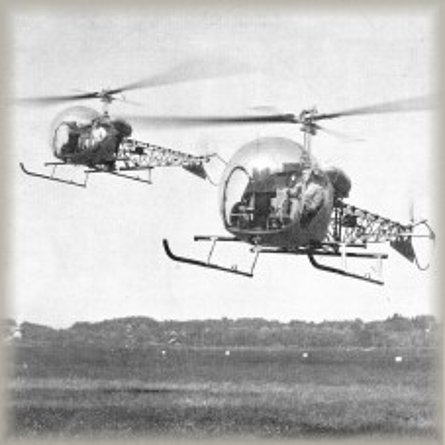
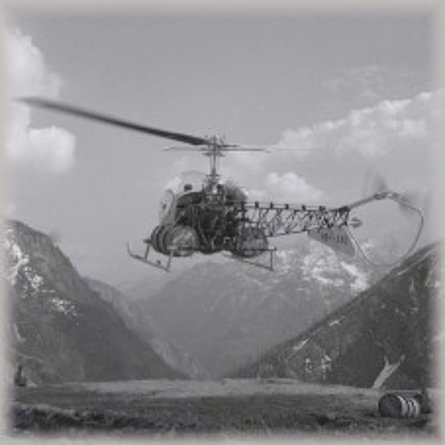
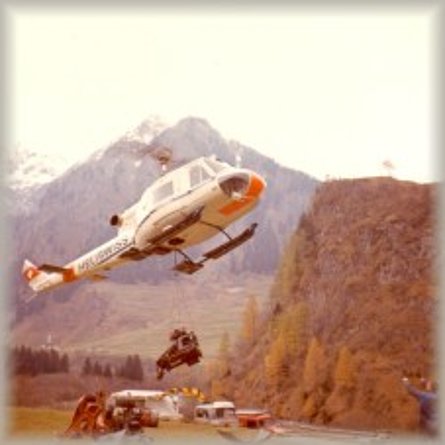
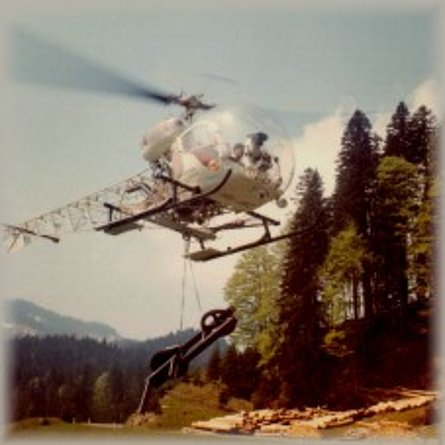
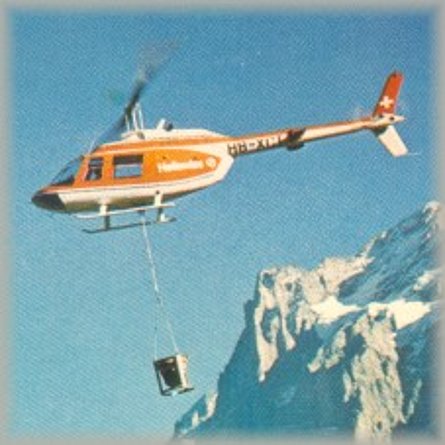
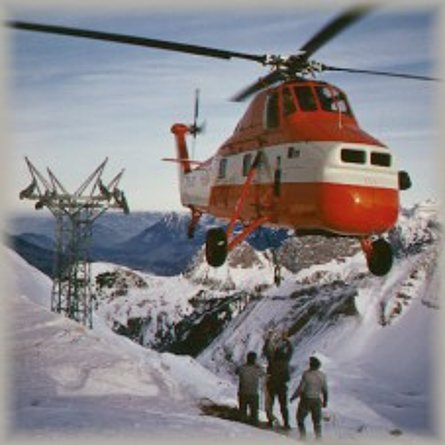
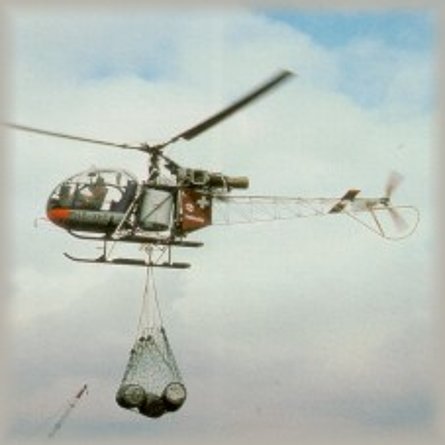
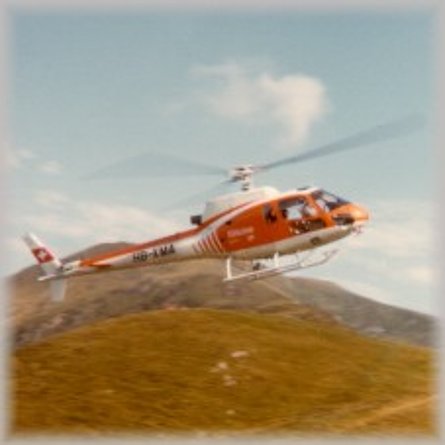
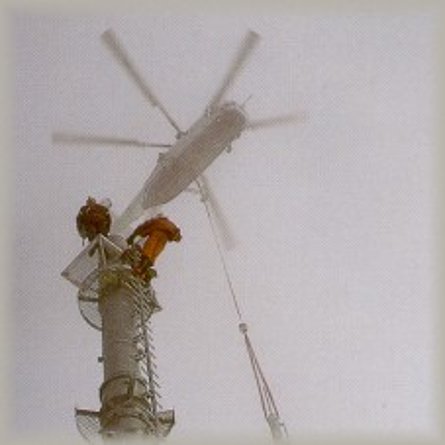
Heliswiss
This firm is today the oldest helicopter operator in Switzerland. Heliswiss was founded in Berne on the 17th April 1953 by a group of businessmen who were optimistic about the future of the helicopter. The financial capital of 350'000.-- Sfr. necessary to its creation was raised among main Swiss public societies such as for example the Swiss Federal Railways, the Swiss Post, or the Canton and the city of Berne.
The company, which established its main base at the airport of Berne-Belp, was initially known as "Schweizerische Helikopter AG". Its first helicopter was the Bell 47G HB-XAG which arrived in Berne the 9th October 1953. Unfortunately a few weeks after its arrival it hit the cables of a power line while flying low over the Aar river and crashed. In the accident the pilot Raymond Gerber and his two passengers lost their life.
Despite the shock the company decided to purchase another Bell 47G (HB-XAE) which arrived in Berne the 27th February 1954. In the meantime Leonard (Leo) Kunz was employed as a pilot. During that year the Bell 47G logged a total of 406 flying hours and 4'500 flights. The investors, seen the positive results, decided to buy another Bell 47G (HB-XAK). During the Winter of 1954/55 Alfred Glauser was trained by Kunz and was then hired as a freelance pilot.
In 1956 Air Import (the first Swiss helicopter operator) was absorbed by Heliswiss. The difficulties and the high operative costs convinced the investors that it was better to concentrate their financial resources in a single company. Everybody was probably convinced that two helicopter companies in Switzerland were too much! Heliswiss employed Air Import’s pilots and extended its fleet, which at that time consisted of helicopters of the Bell 47 series.
During the '60s the request for aerial transportations in the Alps increased, and Heliswiss was consequently forced to put in service bigger helicopter models. With the financial help of the Federal Administration two Agusta-Bell 204B were purchased in 1962. The new turbine powered helicopters HB-XBN and HB-XBO were put in service during 1963. They were capable to lift an external load of 1'000 kg (which was four to five times greater than that lifted by the Bell 47G2 or 9 passengers. Unfortunately the following year the HB-XBN was destroyed in a tragic accident where the pilot lost his life.
Aerial activity increased rapidly in those years. For this reason in order to relieve the customers of over-flight costs and to be closer to their customers the fleet was decentralized, with the result that many regions had of their own helicopter service. New bases were opened in Samedan, Ascona, Lausanne, Riddes, Gruyère, Domat-Ems, Erstfeld, and others. Some were much later closed. The Swiss Air Rescue Guard also benefited from this arrangement, as machines and staff were immediately available in case of emergencies. The principle of decentralization was extended beyond the Swiss borders and the company closely cooperated with other firms as for example Heliaustria in Salzburg.
By the end of the '60s Heliswiss was one of the main European helicopter operator. Its fleet included: one Bell 47G2, four (Agusta-)Bell 47G3B-1, one Bell 47J Ranger, two Bell 206A Jet Ranger and three Agusta-Bell 204B. It must not be forgotten that at that time a considerable part of its activity took place outside the Swiss borders. The helicopters with the Swiss flag flew in the warm African deserts, among the Greenland's icebergs or in South America, especially in Suriname.
To both secure the operational readiness and security of its helicopter fleet, Heliswiss set up its own workshop with a prompt and dependable technical service. Obviously the latter was offered to other helicopter firms or private customers.
In 1968 the company put in service its first Bell 206 Jet Ranger which was soon followed by others. This modern, light-turbine powered helicopter replaced the Bell 47.
In 1969 Heliswiss began the aerial assembly of pylons, antennas, cableways, etc. Pilots and their flight assistants acquired special skills in airborne work on metal and concrete masts, as well as for the building and maintenance of high tension electrical networks. Appropriate auxiliary means were developed and special task-groups were set up for this delicate precision work.
In April 1972 the new Sikorsky S-58T HB-XDT started its activity. With a lift capacity of 2'000-2'200 kg, this twin-turbine powered helicopter was the biggest in service in Switzerland. By the first half of the '70s the company purchased its first SA 315B Lama, which was very much appreciated for its great power reserve. A new step forward was taken when the first Bell 214B-1 was put into service. This helicopter lifted 3'000 kg suspended on its barycentric hook, and could transport up to 15 passengers in its large cabin.
Another very much liked helicopter is the AS 350 Ecureuil (also known as AStar or Squirrell). The first one was put into service in April 1981 (HB-XMA).
The more recent versions of this model (AS 350B2 or B3) have now almost completely replaced the SA 315B Lama. Among the medium size helicopters used there were some Bell 205A-1, and one Bell 412.
In 1990 the company try out the Russian Kamov KA-32 helicopter, an aerial crane with a lift capacity of 5'000 kg. The test results from various difficult assignments were so succesful that the company decided to include this helicopter in its fleet. Two of them are now in service with Heliswiss International AG.
The company operates internationally and is specialized in every kind of transport and installation flight from 300 kg up to 5'000 kg. The main operational areas are the inaccessible mountains and valleys of the alpine countries.
Since 1st of July 2012 Heliswiss (along with Air Grischa, Bohag, Eliticino, Heli Gotthard and Rhein Heli) has joined Swiss Helicopter Ltd., a new company with headquarters in Chur (Switzerland).
Swiss Helicopter has now at disposal 40 helicopters and 14 bases decentralized in Switzerland and has become the largest commercial helicopter operator in Switzerland.
HAB 01/2013

